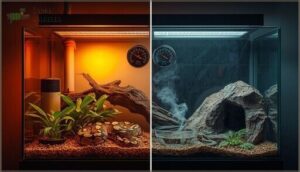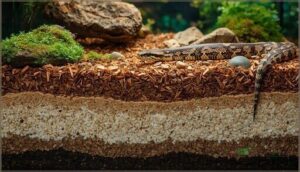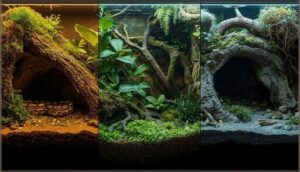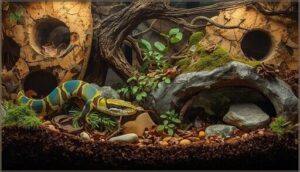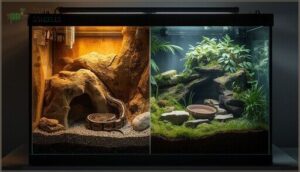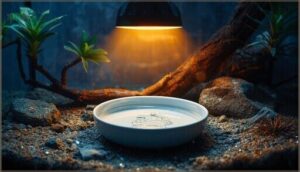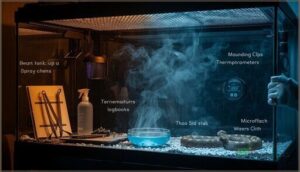This site is supported by our readers. We may earn a commission, at no cost to you, if you purchase through links.
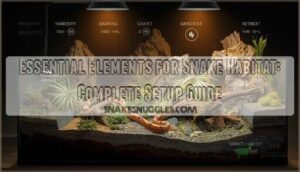
Most captive snakes never experience the environmental complexity they’d encounter in the wild, yet you can recreate the essential elements for snake habitat that support their physiological needs and behavioral repertoire.
The difference between a minimally adequate enclosure and one that promotes genuine welfare often comes down to understanding how temperature gradients, spatial dimensions, and microhabitat features interact to shape your snake’s daily existence.
A corn snake confined to a bare, undersized tank may survive for years while exhibiting chronic stress responses—elevated corticosterone levels, feeding refusal, repetitive locomotion patterns—that remain invisible until serious health complications emerge.
Your setup decisions directly influence thermoregulatory precision, activity budgets, and immune function, making habitat design one of the most consequential aspects of ophidian husbandry.
Table Of Contents
Key Takeaways
- Your snake’s enclosure size must equal at least its full body length with width at half that measurement, as cramped quarters trigger stress hormones that cascade into respiratory issues, muscle atrophy, and a 47% increase in obesity risk from insufficient exercise space.
- Temperature gradients spanning 70°F to 95°F across distinct warm and cool zones aren’t optional—they’re fundamental to your snake’s ability to thermoregulate, digest food properly, and maintain stable metabolic functions throughout its daily rhythm.
- You’ll need at least two strategically placed hides (one in each thermal zone) plus climbing structures for arboreal species, because environmental complexity directly reduces cortisol-driven anxiety that compromises immune function and triggers defensive behaviors.
- Daily spot-cleaning, weekly deep cleans, and monthly substrate replacement form non-negotiable hygiene protocols that prevent pathogen accumulation, while detailed record-keeping of feeding logs, shedding cycles, and behavioral shifts reveals health patterns invisible to memory alone.
Enclosure Size and Space Requirements
Your snake’s enclosure isn’t just a container—it’s the foundation of their physical health and behavioral well-being. When space falls short, you’ll see stress responses, weakened immunity, and even muscle deterioration that shortens their lifespan.
Your snake’s enclosure is the foundation of their physical health and behavioral well-being, not just a container
Let’s break down the specific dimensions your snake needs, based on whether they’re ground-dwellers or climbers, so you can get this right from the start.
Minimum Size Guidelines for Terrestrial Snakes
Your terrestrial snake’s enclosure size directly influences its health and behavior. Calculate minimum dimensions using your snake’s length: enclosure length should equal the snake’s full body length, with width and height at approximately half that measurement. For instance, a 4-foot snake requires at least a 4′ x 2′ x 2′ habitat.
Remember, these represent baseline space requirements—larger enclosures consistently promote enhanced welfare and natural behavioral expression. Ensuring proper snake health and enclosure size is vital for preventing stress-related issues, which can be learned from snake health guidelines.
Enclosure Dimensions for Arboreal Species
Arboreal species flip the space equation—height matters far more than floor area. Your green tree python or emerald tree boa needs an enclosure at least 6 feet tall, with some setups reaching 8 feet to accommodate full vertical movement. Aim for dimensions around 3′ x 2′ x 6′ minimum.
Climbing structures positioned throughout this vertical space aren’t optional; they’re fundamental to preventing the 54.7% spike in stress-related health issues documented in undersized habitats.
For boa constrictors, however, be sure to remember adequate enclosure dimensions for their health.
Calculating Proportional Enclosure Size
Beyond basic minimums, you’ll need to crunch the numbers for your specific snake. Start with enclosure length equal to your snake’s full body length, then calculate width at half that measurement and height at one-third for terrestrial species.
Active species like king snakes demand 1.5 times their length to accommodate natural movement patterns and prevent the muscle atrophy linked to cramped quarters. A 5-foot ball python needs at least 60″ x 30″ x 20″ dimensions.
Effects of Inadequate Space on Health
When you skimp on enclosure size, your snake’s health pays the price. Cramped quarters trigger stress hormones that cascade into respiratory issues and behavioral problems—47% of exotic pets battle obesity from insufficient space for exercise.
Snake muscle atrophy develops as restricted movement prevents full-body stretching, while chronic confinement compounds into serious health consequences affecting everything from bone density to immune function over your snake’s lifespan.
Temperature and Humidity Control
Your snake can’t just pick up a blanket or crack open a window when it’s too hot or cold—it relies entirely on you to create the right environment.
Getting temperature and humidity right isn’t about guesswork; it’s about understanding how these conditions directly affect your snake’s ability to digest food, shed properly, and stay healthy.
Let’s break down the key elements you’ll need to monitor and maintain.
Creating Thermal Gradients
Think of thermal gradients as your snake’s personal climate map—essential for their survival. You’ll need to establish distinct thermal zones across the enclosure, typically spanning 70°F to 95°F, enabling natural thermoregulation.
Position your primary heat source at roughly 25% of the enclosure’s length to create a sturdy warm spot. Use ceramic heat bulbs with pulse proportional thermostats for stable temperature control and ideal gradient design.
Warm and Cool Zone Requirements
Precision in thermal gradients shapes your snake’s daily rhythm. You’ll want a Warm Side maintained at 82–90°F, using regulated heat sources, and a Cool Side held between 72–79°F. This gradient maintenance lets your snake choose its preferred thermal zone for ideal thermoregulation.
Careful temperature control across zones prevents stress, aids digestion, and keeps metabolic functions steady.
Monitoring and Adjusting Humidity Levels
Humidity management hinges on accurate readings and responsive adjustments. You’ll rely on hygrometers, Humidity Sensors, and Humidity Controllers to track levels—placing probes near where your snake rests. Routine Hygrometer Calibration is essential. Water Misting and Fogger Systems boost humidity, especially for tropical species. For consistency, monitor daily and adjust with moisture-retentive substrates or automated misting systems.
- Humidity Sensors placement
- Water Misting routines
- Hygrometer Calibration frequency
Importance of Proper Ventilation
Ever notice how stagnant air feels heavy, almost suffocating? For snakes, poor Airflow Management inside an enclosure spells real trouble—raising risks of respiratory infections and mold.
Effective Ventilation Systems balance Humidity Control and temperature gradients, while Air Quality Monitoring ensures fresh air.
Smart enclosure design, paired with suitable substrate types, promotes Respiratory Health and keeps your habitat safe and comfortable.
Substrate Selection and Maintenance
Choosing the right substrate is more than just picking what looks good—it’s about meeting your snake’s real needs. You’ll want to factor in safety, comfort, and how easy it’s to keep clean.
Let’s look at the options that work best for different species and setups.
Species-Specific Substrate Choices
Is your snake’s substrate deep enough for its natural behaviors? Matching substrate choices to species-specific habitat requirements isn’t just a detail—it’s essential for health and comfort. Consider these specialized substrate types:
- Loose topsoil for burrowing needs
- Coconut husk for humidity control
- Cypress mulch for moisture levels
- Sand-soil blends for desert species
- Layered leaf litter for enrichment
Safe Vs. Harmful Substrate Materials
Your substrate choices can make or break your snake’s health. Aspen bedding works beautifully for dry-climate species, while cypress mulch and coconut fiber excel in humidity control for tropical snakes. But steer clear of cedar and pine—they’re toxic.
Sand, gravel, and bark chips cause impactions and skin damage. Substrate depth matters too: aim for three inches minimum to support natural burrowing and thermoregulation.
Substrate Cleaning and Sterilization
Choosing the right material is just the beginning—keeping it clean protects your snake from infections and parasites. Spot-clean feces immediately to prevent bacterial growth, then replace all substrate monthly.
For sterilization methods, bake soil at 180-200°F for 30 minutes or use a 10% bleach solution followed by thorough rinsing. These hygiene protocols greatly reduce mites and disease risk in your snake’s enclosure.
Role of Substrate in Humidity and Comfort
Beyond hygiene, substrate selection for snakes plays a surprising role in humidity control and microhabitat creation. Moisture-retentive materials like coconut coir or cypress mulch hold water vapor longer than paper alternatives, naturally stabilizing your enclosure’s humidity without constant misting.
Substrate depth matters too—four to six inches lets snakes burrow into cooler, damper layers. This substrate moisture gradient directly improves snake comfort, shedding quality, and respiratory health.
Essential Hideouts and Enrichment
Your snake’s enclosure isn’t complete once you’ve nailed the substrate and temperature zones—you still need to address its behavioral needs. Hideouts and enrichment items directly influence stress levels, activity patterns, and overall health in ways that substrate alone can’t fix.
Here’s what you need to think about when setting up a habitat that fosters natural behaviors and keeps your snake mentally engaged.
Number and Placement of Hides
Effective habitat design begins with understanding your snake’s instinctive need for security. You’ll want to provide at least two hides—one positioned in the warm zone and another in the cool area—to support proper thermoregulation.
For ideal welfare, consider offering three to five strategically placed hiding spots throughout the enclosure, including a humid hide to aid successful ecdysis and maintain hydration.
Climbing Structures for Arboreal Snakes
Arboreal species thrive when you incorporate species-specific climbing structures that accommodate their unique grip mechanics. Natural logs and safe woods like fir provide textured surfaces for concertina locomotion, while varying branch diameters and surface roughness boost vertical space utilization.
Consider these essentials:
- Branch diameter matching your snake’s body width for ideal coiling
- Secure anchoring preventing structural instability
- Multiple climbing levels encouraging natural exploratory behaviors
Maintain 60-80% humidity to support climbing activity and branch stability.
Environmental Enrichment Ideas
Your snake’s world becomes richer through deliberate sensory stimulation and habitat diversity. Puzzle feeders boost foraging behavior by simulating natural hunting patterns, while rotating safe objects—cork rounds, textured branches, leaf litter—encourages snake exploration.
Environmental enrichment activities like introducing novel scents or mixed substrate types stimulate tongue-flicking responses and tactile investigation.
These enrichment activities, paired with climbing structures and strategically placed hiding spots within a proper thermal gradient, foster species-typical behaviors that captive environments often suppress.
Reducing Stress Through Habitat Design
Thoughtful spatial organization transforms your enclosure into a stress-reducing sanctuary. When you establish clear thermal gradients between 24-33°C, position multiple hiding spots across both zones, and maintain humidity control at species-appropriate levels, you’re optimizing welfare through environmental complexity.
This habitat enrichment fosters natural snake behavior—locomotion, thermoregulation, retreat—while minimizing cortisol-driven anxiety that compromises immune function and triggers defensive responses.
Lighting and Water Essentials
Your snake’s lighting and water setup might seem straightforward, but these elements play a surprisingly critical role in supporting natural behaviors and physiological health. Getting the day-night cycle right helps regulate biological processes, while the water source affects everything from hydration to shedding success.
Let’s walk through the key considerations you’ll need to address when setting up these essential components.
Maintaining a Consistent Day-Night Cycle
Your snake’s internal clock runs on precision—disruption throws everything off balance. Establish a consistent photoperiod of 12 hours light and 12 hours darkness to synchronize circadian rhythms and melatonin regulation.
This day-night cycle mimics natural seasonal cycles, supporting metabolism, feeding responses, and immune function.
Use timers to eliminate variability, and guarantee complete darkness at night since even minimal light pollution can disrupt your snake’s biological processes and long-term health.
Lighting Options and Placement
Lighting transforms your enclosure into a functional ecosystem when you position heat lamps to establish thermal gradients—one end at 85-95°F for basking, the other cooler.
You’ll need UVB lighting placed 4-20 inches above basking zones to support calcium absorption, though intensity diminishes with distance. LED options offer energy efficiency without excess heat.
Install lighting timers to maintain your established day-night cycle automatically.
Water Dish Size and Placement
Your water dish should hold enough for full-body soaking—roughly 1 liter for ball pythons, scaling up for larger species. Ceramic bowls offer greater stability compared to lightweight plastics that snakes tip easily.
Position it on the cooler side to reduce evaporation while supporting humidity control and proper hydration. Water depth adequate for soaking behavior aids shedding, especially when temperature gradients make enclosure size management critical.
Ensuring Clean and Accessible Water
Daily water changes prevent bacterial buildup that compromises water quality and triggers dehydration prevention protocols. You’ll want to scrub water bowls weekly with reptile-safe disinfectant, ensuring your snake drinking behavior stays consistent.
Position water source away from heating elements to maintain freshness. Water filtration systems help larger setups, though tap water treated with dechlorinator usually satisfies hydration needs.
Monitor water access daily—snakes refusing water may signal broader health concerns requiring immediate attention.
Safety, Security, and Ongoing Maintenance
A well-designed enclosure means nothing if your snake escapes or equipment fails at the wrong moment. Beyond the initial setup, your responsibility extends to consistent monitoring, proper cleaning protocols, and thorough documentation of your snake’s health patterns.
Let’s examine the critical safety features and maintenance practices that protect both you and your snake throughout its life in captivity.
Escape-Proof Enclosure Designs
Your enclosure design must eliminate every potential escape route, as nearly 70% of escapes stem from improper lid security. Choose glass terrariums with secure lids and sturdy locking mechanisms—keyed locks and interlocking levers prevent snakes from nudging doors open.
Install escape-proof mesh with appropriately small gaps for ventilation while maintaining security. Consider double-door systems for added protection, and regularly inspect all components for wear.
Monitoring Heating Elements and Equipment
Your heating equipment demands constant vigilance. Thermostat calibration ensures temperature gradients stay within safe parameters. Position thermal sensors inside your snake’s primary hide, where accurate temperature regulation matters most.
Check readings daily, as ambient room fluctuations affect heat sources differently across thermal zones. Equipment safety hinges on regulated heating and lighting; unmonitored systems risk burns, overheating, and fire hazards that compromise both your snake’s welfare and your home’s security.
Routine Habitat Cleaning Schedules
Consistent cleaning schedules safeguard reptile health through carefully timed interventions. Daily Spot Cleaning removes waste within minutes, while Weekly Deep Cleans address substrate turnover and décor sanitation. Monthly Sanitizing involves complete substrate replacement and sterilization of all surfaces. Bioactive Maintenance requires less frequent intervention, relying on microbial decomposition.
These Hygiene Protocols form the foundation of enclosure maintenance, preventing pathogen accumulation that compromises your snake’s physiological integrity and long-term wellness.
Record Keeping for Health and Maintenance
Beyond cleaning schedules lies a deeper practice: maintaining detailed snake diaries that track feeding logs, shedding cycles, and behavioral shifts. These care journals provide health monitoring baselines that reveal patterns invisible to memory alone.
Use record templates to document weight changes, refusals, and environmental adjustments—data that transforms regular monitoring and adjustments into precise interventions, keeping your snake healthy while identifying common issues and solutions before they escalate.
Frequently Asked Questions (FAQs)
What diet should I feed my snake?
Your snake’s nutritional needs depend on its species. Most thrive on appropriately sized rodents, delivered frozen-thawed for safety.
Balance protein sources with proper calcium and vitamin D3 supplements, adjusting feeding frequency based on age and size.
How often do snakes typically eat?
Feeding frequency fluctuates fundamentally with species, age, and metabolism. Juveniles require meals every 5–7 days, while adults eat every 1–4 weeks.
Meal intervals depend on digestive adaptations, food availability, and environmental conditions affecting snake behavior.
Can multiple snakes share one enclosure safely?
Housing multiple snakes together isn’t recommended for most species. Only garter snakes naturally cohabit, but even they show aggression in 77% of trials.
Species-specific considerations and proper enclosure size remain critical for responsible care.
What signs indicate my snake is sick?
Like the proverbial canary in the coal mine, your snake’s behavioral changes—lethargy, refusal to eat, or unusual hiding—often signal health problems first.
Watch for respiratory issues, dermatological signs, neurological symptoms, gastrointestinal problems, or parasite infestations requiring immediate veterinary attention.
How do I handle my snake properly?
Wait 48 hours after feeding before handling techniques begin.
Support your snake’s body gently, avoid sudden movements, and watch for stress signals like rapid breathing.
Wash hands before and after for safety precautions and responsible pet ownership.
Conclusion
The irony of snake keeping lies in this: replicating nature requires more deliberate intervention than most keepers anticipate. Your snake can’t communicate its discomfort until pathology manifests, making preemptive habitat optimization your primary diagnostic tool.
Every essential element for snake habitat—spatial adequacy, thermal precision, microhabitat complexity—functions as preventive medicine, not luxury. When you treat enclosure design as ongoing biological research rather than static decoration, you transform captivity from confinement into something approaching ecological authenticity.
- https://www.reddit.com/r/snakes/comments/up4i1e/rule_of_thumb_for_enclosure_size/
- https://www.thefbh.org/post/statement-from-tariq-abou-zahr-on-awc-review-on-the-space-requirements-for-snakes
- https://www.youtube.com/watch?v=BA7Lx7md0_g
- https://static1.squarespace.com/static/6268f004e9da29777b080f8f/t/645aa4a4bce9de6feca4faab/1683661990992/FBH+Recommended+Minimum+Enclosure+Size.pdf
- https://reptifiles.com/heterodon-hognose-snake-care/hognose-snake-enclosure-size/

